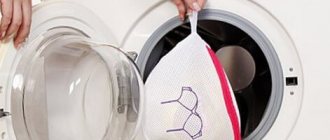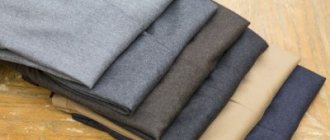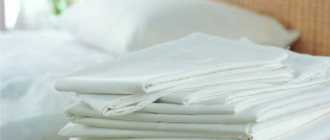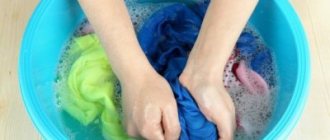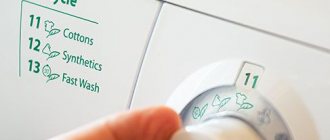At first glance, there is nothing complicated in washing bed linen, because most often it is made from fairly dense fabrics - calico, satin, silk, linen, and complex stains rarely appear on it. But there is another side to the coin: sheets, duvet covers and pillowcases are used intensively and washed often, so it is important to know a number of secrets that will help keep them attractive for a long time.
Modern bed linen is made from different types of fabrics
How to properly wash bed linen? The temperature and washing mode largely depend on the type of fabric from which it is made, but there are general rules that every housewife should know. Let's start with them.
Wash bedding in the washing machine following the instructions on the set label.
Washing frequency
Bed linen should be washed at least once every 7-10 days. During sleep, skin particles, germs, hair, sweat, and poorly washed off cosmetics remain on the pillowcase, sheet and duvet cover. If you do not properly care for your bedding, your pet’s “collection” will be replenished with microscopic insects, and fungi and bacteria will appear. In addition, the fabric gradually accumulates dirt and, if it is not washed for a long time, it will become gray and covered with stains, which will be very difficult to remove.
In some cases, the bed may need to be changed more often. For example, children, especially small ones (under 6 years old), need to be changed every 2-3 days. It is especially important for teenagers to change their pillowcase frequently - once every 1-2 days, since one of the causes of acne is clogging of the sebaceous glands with dust and dirt located on the surface of the pillow. Also, the bed is a favorable environment for the growth of bacteria that cause skin infections and diseases. If a person is sick, you need to wash your clothes every day or every 2 days to deprive germs of such an environment. If this is not possible, you should at least change your pillowcase daily.
The time of year also affects. In summer you need to wash your bed more often than in winter, since sweating increases in the warm season. The optimal interval between washes is 2-3 days.
Important! New linen must be washed before use. This will help remove the factory smell, as well as the impregnations that give the kit its “marketable appearance.”
Preparation
Before washing, laundry must be prepared. The sequence is as follows:
- Read the label carefully. Many people neglect the information on the label, some even throw it away because they consider it unnecessary. However, careful familiarization with the acceptable conditions for washing, ironing and drying can not only make the item visually attractive, but also save it.
- Sorting. Light and dark-colored items should be washed separately to avoid staining. Linen and calico should not be used together with silk. Synthetics should only be washed with synthetics, and natural fabrics with natural ones. In addition, children’s sets and linen should be washed after a sick person separately from others.
- Turning all pillowcases and duvet covers inside out. Check whether debris and dirt have accumulated in their corners; if there are zippers on the linen, fasten them.
- Pre-soaking heavily soiled items. You must first place the kit in warm water (50-60°C) with some detergent - laundry soap, powder or gel. It is preferable to wash dark fabrics with liquid detergents, as they do not leave streaks.
Adviсe:
- Before putting things in the washing machine, you need to put the drum in order - wipe it inside with a dry cloth. Also run a sponge under the rubber seal several times.
- When drying, straighten the laundry. Iron only when damp or immediately lay down and smooth out.
- If you notice even the slightest dirt, send the set to the wash.
- After purchasing new laundry, be sure to disinfect it by setting it to pre-wash.
- Use liquid powders and conditioners.
- Don't leave wrinkled laundry in the hamper.
- Wash linen even after only one use by guests.
- Before drying on a clothesline, shake thoroughly and hang without folding it in half.
- If you use clothespins, try to hook them along the edges, otherwise they will leave a mark.
- When drying, do not expose the kit to sunlight.
- Try to use several sleep sets.
Knowing how to machine wash bedding can help you do other household chores or take some time for yourself. Happy washing!
Loading laundry into the machine
Load laundry into the washing machine according to its capacity. You should not try to fill the drum as much as possible; it is better to always leave a little free space - about 1/3 of the volume. So, washing, rinsing and spinning will be better. The permissible weight of loaded laundry is indicated on the machine itself or in the instructions. An average set of single bed linen weighs approximately 1.5 kg: about 400 g, two pillowcases, 300-400 g sheets and 500-700 g duvet cover. Therefore, a double set will weigh 2-2.5 kg depending on the weight of the material.
Selecting temperature and mode depending on the type of fabric
All modern washing machines have basic and additional modes. Which one to choose depends on the type of fabric and degree of contamination.
The washing temperature depends on how dirty the laundry is. The more spots, the hotter the water. However, linens with patterns may fade when the temperature rises.
Cotton fabrics
Cotton and linen are the most unpretentious and affordable fabrics. We can say that a bed made of these materials is the most comfortable and practical, because it is beautiful, pleasant to the touch, practical and inexpensive.
Many modern models of automatic machines have a “Cotton” mode. We set the spin speed to 1200 rpm.
The temperature for washing cotton and linen fabrics without a pattern is 60°C, colored fabrics are 40-50°C. Heavily soiled bed linen can be washed at 90 degrees.
Cotton baby bedding should be washed at temperatures above 60°C to ensure it cleans better.
Linen and cotton dry quickly; they are not picky in this matter. However, you should not leave a set with a pattern in the sun, as it may fade.
Blended fabrics with added synthetics
You need to wash clothes made from fabrics with a combined composition carefully, since such materials are quite capricious, can shrink or become very deformed, and the pattern on such sets is erased quickly. Synthetics are not as convenient and healthy, but they are cheap, which is why they are popular. It is also resistant to aggressive influences and chemicals. There are several types of mixed fabrics:
- Polycotton is a mixture of polyester and cotton threads.
- Poplin is a combination of cotton and chemical fibers.
- Microfiber – 100% polyester.
- Percale is a mixture of 50% cotton and 50% polyester.
- Viscose is a cellulose-based fabric.
Washing clothes made from such materials should be done at low temperatures – no higher than 40°C. The “Synthetic” or “Delicate Wash” modes will provide the necessary care for synthetic sets.
Before washing bedding made from mixed fabrics, it is necessary to soak it. But you shouldn’t rub, because under the influence of external forces, pellets appear, which not only spoil the appearance, but are also unpleasant for the body.
Satin
Satin is a type of cotton fabric. This material has high density and strength, quality, and remains in good condition even after a couple of hundred washes.
You should not use bleach, especially when washing colored fabrics - this leads to fading of the design and rapid abrasion.
Satin bed linen should be washed at a temperature of no more than 40°C, and for heavily soiled items – at 60°C. You should use the “Delicate Wash” mode with a spin speed of less than 600.
Satin is a slightly wrinkled material, but it needs to be ironed to remove remaining germs and bacteria.
Attention! After washing, satin may shrink slightly, but manufacturers usually make bedding sets with this in mind.
Bamboo
Recently, bamboo beds have become especially common. The advantages of this material are that it is very soft, but durable, and has antibacterial properties that last for a long time.
If possible, wash bamboo clothes by hand at low temperatures. In this case, you should use gels that have a gentle effect.
Bamboo can also be washed in a machine, but at a temperature not exceeding 30°C, in the “Delicate Wash” mode. The spin must be set to minimum or even dispensed with.
Bamboo fabric should be dried on a horizontal surface so that it does not become deformed.
Silk
Silk is an expensive, luxury fabric. However, the properties justify the price: it is soft, durable, pleasant to the touch, and has a noble shine.
Silk bed linen must be washed at a temperature of 30°C, no higher. This is due to the fact that silk sheds quite a lot, and hot water will only speed up the process. You should select the “Delicate Wash” or “Hand Wash” mode. Spinning, twisting, rubbing and other manipulations with laundry can damage it. It is better to rinse the material in warm or cool water and dry it away from heating appliances. No soaking required. But you still need to iron the silk, but at a minimum temperature, without steaming.
Made from poplin
Caring for poplin is not difficult at all. Poplin is recommended to be machine washed at 30-40°C. It does not stretch and retains its shape and color perfectly even after a large number of washes. This fabric does not need to be ironed as it has low creaseability.
Poplin bed linen has recently become especially popular. When choosing fabric for bed linen, people most often pay attention to such characteristics as its wear resistance, ease of care, and the naturalness of the fabric. Poplin is easy to wash at low temperatures. There is no need to iron it after washing - it smooths itself out after the bed is made with it, and then retains its neat appearance and freshness for a long time.
Poplin is often used to make bedding for little ones. The naturalness and softness of the fabric is very important for children, and poplin meets all these requirements. This type of linen can be used all year round - it allows air to pass through in the summer and retains heat in the winter. The fabric is very pleasant to the body, its softness ensures a sound, comfortable sleep. The colors of poplin are varied - it can be a noble check, a cheerful stripe, a beautiful delicate printed pattern, or a classic white color.
Choice of product
To ensure that your bed linen becomes clean after washing and does not lose its color and structure, you should know a few tips:
- For natural fabric, a powder that does not foam much is well suited.
- If the water in your area is hard, you should use a water softener. It will not only protect the machine from scale, but will also preserve the properties of the fabric. In this case, it is necessary to use more of the main product than when washing in soft water.
- It is worth washing things of people with allergies using liquid products rather than powders. The same applies to dark fabrics.
- There is no need to exceed the dosage of detergent; use exactly as much as indicated in the instructions.
- You cannot wash with expired products. The chemicals they contain become toxic to people, especially children.
Made from linen
The recommended temperature for linen products is 60 degrees. For white, universal powders are used; for colors, delicate detergents for delicate fabrics are used. Check the composition - options without bleaches are suitable. To improve the properties of linen fabric, it is impregnated with starch, fats, cellulose ethers, synthetic resins and other substances. Impregnation makes linen more resistant to shrinkage and deformation and wrinkles less. The recommended temperature is 40 degrees.
To make linen wash better, it is soaped and left in warm water for one hour. Then pour the powder and a tablespoon of vinegar into the water. Wash, rinse in cold water and dry. Soaked flax should not be dried on radiators or in special dryers - it may shrink. Iron, moistening the fabric. It is easier to iron under-dried items.
Does the new set need to be washed?
Many people ask this question and, after thinking about it, skip washing the set after purchase. And they are very mistaken, because the laundry needs to be cleaned of factory chemicals and the unpleasant odor removed. Most often, in factories, fabric is treated with a compound that helps it keep its shape. In addition, during the production process, dust and dirt, which are harmful to the human body, settle on the linen.
New bedding should be washed at the highest permissible temperature in order to disinfect it as thoroughly as possible. It will also remove excess paint, making the kit more attractive.
The fabric may shrink a little, but that’s not a big deal: the manufacturers have thought of everything.
Features of washing baby clothes
Washing children's sets is a little different from usual.
Firstly, children are more active, so their bed quickly becomes dirty with crumbs, stains, and sweat. You can remove all this with laundry soap.
Secondly, children's things need to be disinfected more thoroughly. Therefore, it is recommended to wash in the “Baby” or “Delicate” mode at a temperature of 60°C or higher, if the type of fabric allows.
Thirdly, children are more prone to allergies, so it is better to use hypoallergenic gels; it is not recommended to take powders.
It is also worth remembering that children’s sets must be washed separately from adults, and oilcloths must be washed by hand.
When ironing is required
Ironing large items is extremely tiring. There are SMAs that provide easy ironing and anti-crease functions. After the automated processes carried out by CMA, ironing duvet covers manually seems like an unaffordable waste of time. Everyone decides for themselves whether to iron or not. We will just name the situations in which it is better to go over the bedding with a hot iron:
- If someone in the household is sick. Ironing is necessary to prevent the infection from being transmitted through the bed. It is recommended to provide the patient with separate supplies.
- Kits used for children up to one year old.
- With high humidity, in which things cannot dry completely.
How to wash faded clothes?
Unfortunately, many fabrics, especially bright ones, can fade a lot. To check whether a material has this property, you need to run a damp cloth over it and see if a colored mark remains on it.
To prevent things from shedding, you can soak them for 50-60 minutes in a solution of vinegar (1 tsp per 1 l), salt (1 tbsp per 1 l) or ammonia (5 drops per 1 l) in water . Afterwards, you need to thoroughly rinse the kit and put it into the automatic machine.
You can wash stained laundry using bleach for colored items (marked “Color”). In this case, the temperature should be set below 40°C.
Made of velvet
Washing machine is contraindicated for velvet. However, such underwear is rare - it is for “gourmets”. The velvet is not rubbed or twisted, and is handled as gently as possible. Temperature - up to 30 degrees. Instead of powder - gel. You can't squeeze it. Dry, spread out on the table, on a large towel. Roll it up and press down a little so that the water comes out. After changing the towel, repeat the process. Dry in a horizontal position or hang in the shade. When the velvet is dry, shake it so that the pile settles correctly.
How to wash heavily soiled laundry?
It happens that over time the bed becomes gray or yellow, stains appear on it that are almost impossible to remove.
There are products that help wash washed bed linen, for example, Domestos and Belizna bleaches. It is necessary to soak the bedding set in water using the selected product in accordance with the instructions indicated on the package.
There are also traditional methods of dealing with yellowness and spots:
- Ammonia. A few drops should be added to very warm water when soaking. After half an hour, gently wring out the fabric and put it in the washing machine.
- Boric acid. 2 tbsp. l. must be dissolved in 3 liters of water. Soak for 40-50 minutes, then wash.
- Hydrogen peroxide. 1 tbsp. need to be diluted in 3 liters of water, left for 30-40 minutes.
- Yellow stains can be washed off with laundry soap or Antipyatin. First, you should gently rub the dirt with it, then soak the item in a soapy solution for 3-4 hours.
What to do if the bed smells unpleasant after washing?
An unpleasant smell from clothes after washing can appear for several reasons:
- Irregular ventilation of the drum.
- Using the wrong powder.
- Excessive use of cleaning solutions.
- Leaving dirty or wet clothes in the drum for a long time.
- Lack of proper care of the washing machine.
- Incorrect connection of the hose to the sewer.
You can combat this in the following ways:
- Troubleshooting automatic machine operation. To do this, it is better to call qualified craftsmen; you should not carry out repairs yourself, as this can only worsen the situation.
- If there is mold on the drum, you should treat it with a solution of copper sulfate and leave it for a day.
- You can wash your laundry from the “aroma” of dampness using 150 g of citric acid and 100 g of soda poured into the machine. To do this, you need to set the longest mode and temperature to 90°C.
- A small amount of vinegar also works great for removing musty odors.


